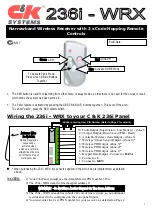
1
2
3
4
5
6
7
8
9
10
11
12
13
14
15
16
17
18
19
20
21
40
SCAN
Scan is a useful feature for hands-off monitoring of your
favorite frequencies. After becoming comfortable with how
to use all types of Scan, the monitoring flexibility gained will
increase your operating efficiency.
This transceiver provides the following conventional scans
in addition to “Visual Scan” {page 41} that may be new to
you.
VFO Scan
Memory Scan
Program Scan
MHz Scan
Call/VFO Scan
Call/Memory Scan
All frequencies tunable on the
band
Frequencies stored in the memory
channels
All frequencies in the range
selected on the band
All frequencies within 1 MHz
range
Call channel plus the current VFO
frequency
Call channel plus the memory
channel last used
Scan Range
Scan Type
When using with CTCSS and/or DTSS:
•
While using CTCSS, Scan stops and the squelch opens only
when received signals contain the matching CTCSS tone.
•
While using DTSS, Scan stops for any signals received.
However, if the signals do not contain the matching DTSS
code, the squelch does not open.
•
When both CTCSS and DTSS are ON, Scan stops for signals
that contain the matching CTCSS tone. However, if the
signals do not contain the matching DTSS code, the squelch
does not open.
Note:
◆
Remember to adjust the squelch threshold level before using Scan.
◆
Always turn OFF Monitor {page 73} and Page before using Scan.
◆
When using S-meter Squelch, Scan stops when the received signal
strength matches or exceeds the S-meter setting. Scan resumes 2
seconds after the signal level drops below the S-meter setting.
















































